Evaluation of Microstructure and Mechanical Properties of Al-TiC Metal Matrix Composite Prepared by Conventional, Microwave and Spark Plasma Sintering Methods
Abstract
:1. Introduction
2. Results and Discussion
3. Experimental Procedures
3.1. Preparation of Composite
3.2. Sintering Process
3.3. Microstructure and Mechanical Properties
4. Conclusions
Author Contributions
Conflicts of Interest
References
- Shin, J.H.; Choi, H.J.; Bae, D.H. The structure and properties of 2024 aluminum composites reinforced with TiO 2 nanoparticles. Mater. Sci. Eng. A. 2014, 607, 605–610. [Google Scholar] [CrossRef]
- Torralba, J.; da Costa, C.; Velasco, F. P/M aluminum matrix composites: An overview. J. Mater. Process. Technol. 2003, 133, 203–206. [Google Scholar] [CrossRef]
- Ghasali, E.; Yazdani-rad, R.; Asadian, K.; Ebadzadeh, T. Production of Al-SiC-TiC hybrid composites using pure and 1056 aluminum powders prepared through microwave and conventional heating methods. J. Alloys Compd. 2017, 690, 512–518. [Google Scholar] [CrossRef]
- Ghasali, E.; Alizadeh, M.; Ebadzadeh, T.; Pakseresht, A.H.; Rahbari, A. Investigation on microstructural and mechanical properties of B4C–aluminum matrix composites prepared by microwave sintering. J. Mater. Res. Technol. 2015, 4, 411–415. [Google Scholar] [CrossRef]
- Das, T.; Munroe, P.; Bandyopadhyay, S. The effect of Al 2 O 3 particulates on the precipitation behaviour of 6061 aluminium-matrix composites. J. Mater. Sci. 1996, 31, 5351–5361. [Google Scholar] [CrossRef]
- Ghosh, S.K.; Saha, P. Crack and wear behavior of SiC particulate reinforced aluminium based metal matrix composite fabricated by direct metal laser sintering process. Mater. Des. 2011, 32, 139–145. [Google Scholar] [CrossRef]
- Kheder, A.; Marahleh, G.; Al-Jamea, D. Strengthening of Aluminum by SiC, Al2O3 and MgO. Jordan J. Mech. Ind. Eng. 2011, 5, 533–541. [Google Scholar]
- Ghasali, E.; Pakseresht, A.H.; Agheli, M.; Marzbanpour, A.H.; Ebadzadeh, T. WC-Co particles reinforced aluminum matrix by conventional and microwave sintering. Mater. Res. 2015, 18, 1197–1202. [Google Scholar] [CrossRef]
- Ghasali, E.; Alizadeh, M.; Ebadzadeh, T. Mechanical and microstructure comparison between microwave and spark plasma sintering of Al–B 4 C composite. J. Alloys Compd. 2016, 655, 93–98. [Google Scholar] [CrossRef]
- Asadipanah, Z.; Rajabi, M. Production of Al–ZrB2 nano-composites by microwave sintering process. J. Mater. Sci. Mater. Electron. 2015, 26, 6148–6156. [Google Scholar] [CrossRef]
- Ghasali, E.; Pakseresht, A.; Rahbari, A.; Eslami-Shahed, H.; Alizadeh, M.; Ebadzadeh, T. Mechanical properties and microstructure characterization of spark plasma and conventional sintering of Al–SiC–TiC composites. J. Alloys Compd. 2016, 666, 366–371. [Google Scholar] [CrossRef]
- Abdizadeh, H.; Ashuri, M.; Moghadam, P.T.; Nouribahadory, A.; Baharvandi, H.R. Improvement in physical and mechanical properties of aluminum/zircon composites fabricated by powder metallurgy method. Mater. Des. 2011, 32, 4417–4423. [Google Scholar] [CrossRef]
- Abdizadeh, H.; Baharvandi, H.; Moghaddam, K.S. Comparing the effect of processing temperature on microstructure and mechanical behavior of (ZrSiO 4 or TiB 2)/aluminum composites. Mater. Sci. Eng. A 2008, 498, 53–58. [Google Scholar] [CrossRef]
- Akbari, M.K.; Rajabi, S.; Shirvanimoghaddam, K.; Baharvandi, H. Wear and friction behavior of nanosized TiB 2 and TiO 2 particle-reinforced casting A356 aluminum nanocomposites: A comparative study focusing on particle capture in matrix. J. Composite Mater. 2015, 49, 3665–3681. [Google Scholar] [CrossRef]
- Rajabi, A.; Ghazali, M.J.; Daud, A. Chemical composition, microstructure and sintering temperature modifications on mechanical properties of TiC-based cermet—A review. Mater. Des. 2015, 67, 95–106. [Google Scholar] [CrossRef]
- Sheibani, S.; Najafabadi, M.F. In situ fabrication of Al–TiC metal matrix composites by reactive slag process. Mater. Des. 2007, 28, 2373–2378. [Google Scholar] [CrossRef]
- Mohapatra, S.; Chaubey, A.K.; Mishra, D.K.; Singh, S.K. Fabrication of Al–TiC composites by hot consolidation technique: its microstructure and mechanical properties. J. Mater. Res. Technol. 2016, 5, 117–122. [Google Scholar] [CrossRef]
- López, V.; Kennedy, A.; Lemus, J. Characterization of the reactivity in Al-10 wt. % TiC metal matrix composites by image analysis. Kovove Mater. 2010, 48, 17–24. [Google Scholar]
- Yan, M.; Fan, Z. Review Durability of materials in molten aluminum alloys. J. Mater. Sci. 2001, 36, 285–295. [Google Scholar] [CrossRef]
- Leon, C.; Lopez, V.; Bedolla, E.; Drew, R. Review durability of materials in molten aluminum alloys. J. Mater. Sci. 2002, 37, 3509–3514. [Google Scholar] [CrossRef]
- Mitra, R.; Fine, M.; Weertman, J. Chemical reaction strengthening of Al/TiC metal matrix composites by isothermal heat treatment at 913 K. J. Mater. Sci. 1993, 8, 2370–2379. [Google Scholar] [CrossRef]
- Samer, N.; Andrieux, J.; Gardiola, B.; Karnatak, N.; Martin, O.; Kurita, H.; Chaffron, L.; Gourdet, S.; Lay, S.; Dezellus, O. Microstructure and mechanical properties of an Al–TiC metal matrix composite obtained by reactive synthesis. Compos. Part. A Appl. Sci. Manuf. 2015, 72, 50–57. [Google Scholar] [CrossRef] [Green Version]
- Wu, X.; Sun, T.; Wang, R.; Liu, L.; Liu, Q. Energy investigations on the adhesive properties of Al/TiC interfaces: First-principles study. Phys. B Condens. Matter 2014, 449, 269–273. [Google Scholar] [CrossRef]
- Ghasali, E.; Palizdar, Y.; Jam, A.; Rajaei, H.; Ebadzadeh, T. Effect of Al and Mo addition on phase formation, mechanical and microstructure properties of spark plasma sintered iron alloy. Mater. Today Commun. 2017, 13, 221–231. [Google Scholar] [CrossRef]
- Kennedy, A.; Wyatt, S. The effect of processing on the mechanical properties and interfacial strength of aluminium/TiC MMCs. Compos. Sci. Technol. 2000, 60, 307–314. [Google Scholar] [CrossRef]
- Lloyd, D. Particle reinforced aluminium and magnesium matrix composites. Int. Mater. Rev. 1994, 39, 1–23. [Google Scholar] [CrossRef]
- Padmavathi, C.; Upadhyaya, A. Densification, microstructure and properties of supersolidus liquid phase sintered 6711Al-SiC metal matrix composites. Sci. Sinter. 2010, 42, 363–382. [Google Scholar] [CrossRef] [Green Version]
- Dinaharan, I.; Murugan, N. Dry sliding wear behavior of AA6061/ZrB2 in-situ composite. Trans. Nonferrous Met. Soc. China 2012, 22, 810–818. [Google Scholar] [CrossRef]
- Laha, T.; Agarwal, A.; McKechnie, T.; Seal, S. Synthesis and characterization of plasma spray formed carbon nanotube reinforced aluminum composite. Mater. Sci. Eng. A 2004, 381, 249–258. [Google Scholar] [CrossRef]
- Ghasali, E.; Nouranian, H.; Rahbari, A.; Majidian, H.; Alizadeh, M.; Ebadzadeh, T. Low temperature sintering of aluminum-zircon metal matrix composite prepared by spark plasma sintering. Mater. Res. 2016, 19, 1189–1192. [Google Scholar] [CrossRef]
- Kala, H.; Mer, K.; Kumar, S. A Review on Mechanical and Tribological Behaviors of Stir Cast Aluminum Matrix Composites. Procedia Mater. Sci. 2014, 6, 1951–1960. [Google Scholar] [CrossRef]
- Ibrahim, I.; Mohamed, F.; Lavernia, E. Particulate reinforced metal matrix composites—A review. J. Mater. Sci. 1991, 26, 1137–1156. [Google Scholar] [CrossRef]
- Liu, Y.; Lim, S.; Lu, L.; Lai, M. Recent development in the fabrication of metal matrix-particulate composites using powder metallurgy techniques. J. Mater. Sci. 1994, 29, 1999–2007. [Google Scholar] [CrossRef]
- Majidian, H.; Ghasali, E.; Ebadzadeh, T.; Razavi, M. Effect of heating method on microstructure and mechanical properties of zircon reinforced aluminum composites. Mater. Res. 2016, 19, 1443–1448. [Google Scholar] [CrossRef]
- Cetin, A.; Kalkanli, A. Effect of solidification rate on spatial distribution of SiC particles in A356 alloy composites. J. Mater. Process. Technol. 2008, 205, 1–8. [Google Scholar] [CrossRef]
- Skibo, M.D.; Schuster, D.M. Process for Preparation of Composite Materials Containing Nonmetallic Particles in a Metallic Matrix. U.S. Patent No. 4,865,806, 12 September 1989. [Google Scholar]
- Rana, R.; Purohit, R.; Das, S. Review of recent studies in Al matrix composites. Int. J. Sci. Eng. Res. 2012, 3, 1–16. [Google Scholar]
- Narasimha, B.G.; Krishna, V.M.; Xavior, A.M. A review on processing of particulate metal matrix composites and its properties. Int. J. Appl. Eng. Res. 2013, 8, 647–666. [Google Scholar]
- Bathula, S.; Anandani, R.; Dhar, A.; Srivastava, A. Microstructural features and mechanical properties of Al 5083/SiC p metal matrix nanocomposites produced by high energy ball milling and spark plasma sintering. Mater. Sci. Eng. A 2012, 545, 97–102. [Google Scholar] [CrossRef]
- Hungría, T.; Galy, J.; Castro, A. Spark Plasma Sintering as a Useful Technique to the Nanostructuration of Piezo-Ferroelectric Materials. Adv. Eng. Mater. 2009, 11, 615–631. [Google Scholar] [CrossRef]
- Munir, Z.; Anselmi-Tamburini, U.; Ohyanagi, M. The effect of electric field and pressure on the synthesis and consolidation of materials: a review of the spark plasma sintering method. J. Mater. Sci. 2006, 41, 763–777. [Google Scholar] [CrossRef]
- Saheb, N. Spark plasma and microwave sintering of Al6061 and Al2124 alloys. Int. J. Miner. Met. Mater. 2013, 2, 152–159. [Google Scholar] [CrossRef]
- Delaizir, G.; Bernard-Granger, G.; Monnier, J.; Grodzki, R.; Kim-Hak, O.; Szkutnik, P.-D.; Soulier, M.; Saunier, S.; Goeuriot, D.; Rouleau, O. A comparative study of spark plasma sintering (SPS), hot isostatic pressing (HIP) and microwaves sintering techniques on p-type Bi 2 Te 3 thermoelectric properties. Mater. Res. Bull. 2012, 47, 1954–1960. [Google Scholar] [CrossRef]
- Rajeswari, K.; Hareesh, U.; Subasri, R.; Chakravarty, D.; Johnson, R. Comparative evaluation of spark plasma (SPS), microwave (MWS), two stage sintering (TSS) and conventional sintering (CRH) on the densification and micro structural evolution of fully stabilized zirconia ceramics. Sci. Sinter. 2010, 42, 259–267. [Google Scholar] [CrossRef]
- Munir, Z.A.; Quach, D.V.; Ohyanagi, M. Electric current activation of sintering: a review of the pulsed electric current sintering process. J. Am. Ceram. Soc. 2011, 94, 1–19. [Google Scholar] [CrossRef]
- Ali, M.; Falih, S. Synthesis and Characterization of Aluminum Composites Materials Reinforced with TiC Nano-Particles. Jordan J. Mech. Ind. Eng. 2014, 8, 257–264. [Google Scholar]
- Kennedy, A.; Wyatt, S. Characterising particle–matrix interfacial bonding in particulate Al–TiC MMCs produced by different methods. Compos. Part. A. Appl. Sci. Manuf. 2001, 32, 555–559. [Google Scholar] [CrossRef]
- Shimada, S.; Mochidsuki, K. The oxidation of TiC in dry oxygen, wet oxygen, and water vapor. J. Mater. Sci. 2004, 39, 581–586. [Google Scholar] [CrossRef]
- Korablev, S. Chemical and kinetic features of oxidation of powder titanium carbide. Refract. Ind. Ceram. 1999, 40, 534–536. [Google Scholar] [CrossRef]
- Das, G.; Chatterjee, D.K.; Lipsitt, H.A. Electron irradiation damage in TiC. J. Mater. Sci. 1981, 16, 3283–3291. [Google Scholar] [CrossRef]
- Viala, J.; Vincent, C.; Vincent, H.; Bouix, J. Thermodynamic approach of the chemical interaction between al and tic. Mater. Res. Bull. 1990, 25, 457–464. [Google Scholar] [CrossRef]
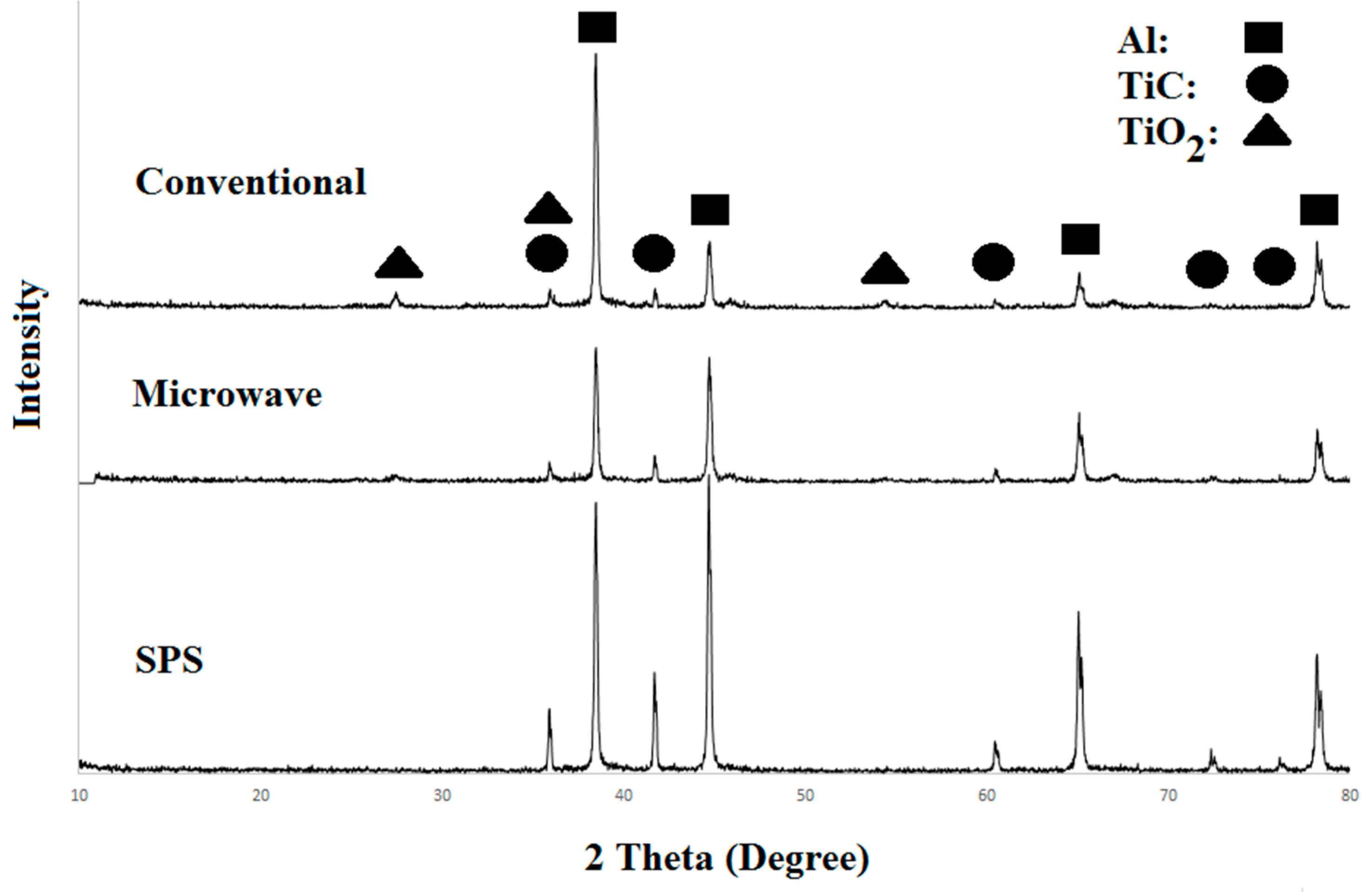

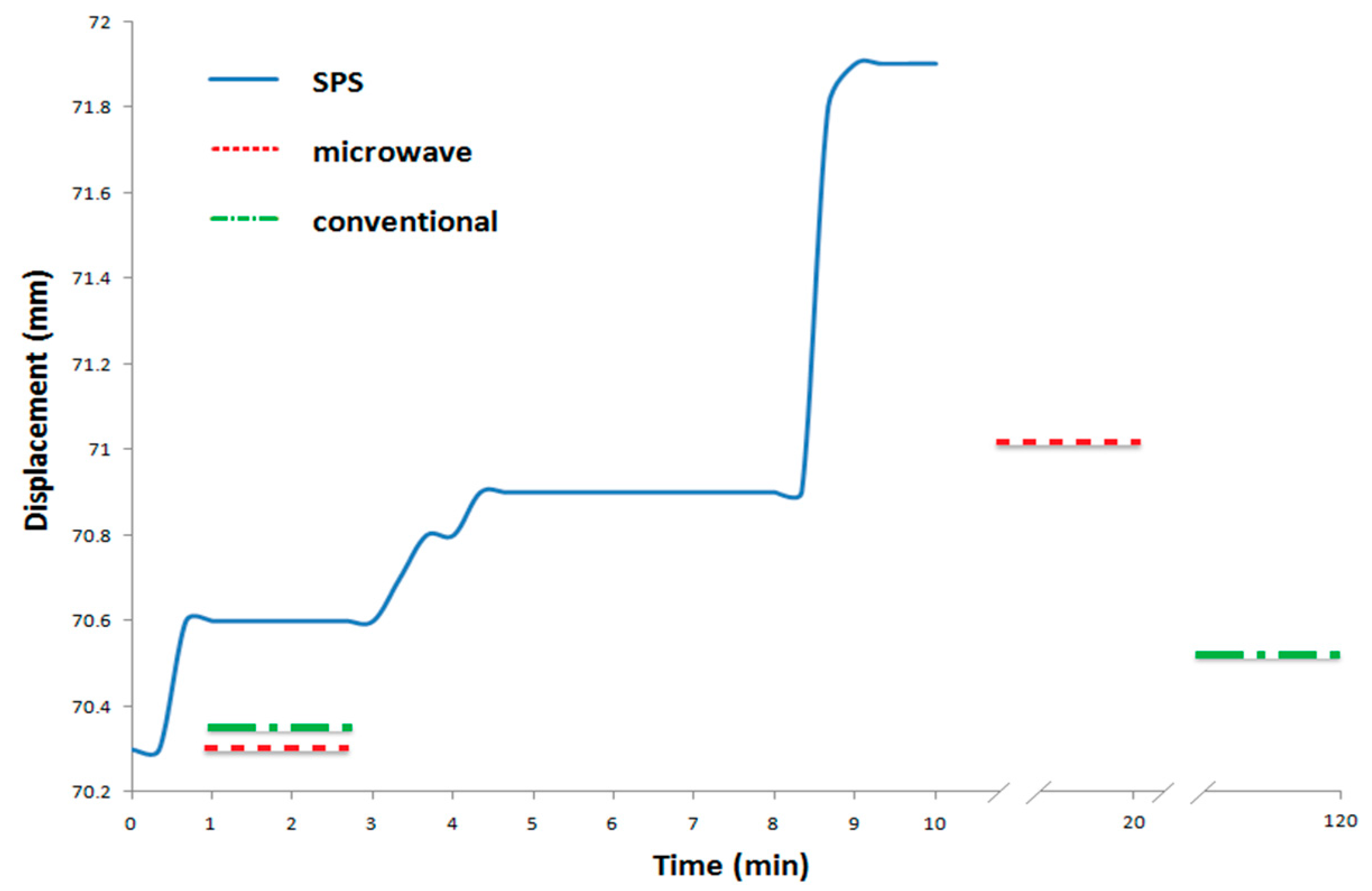


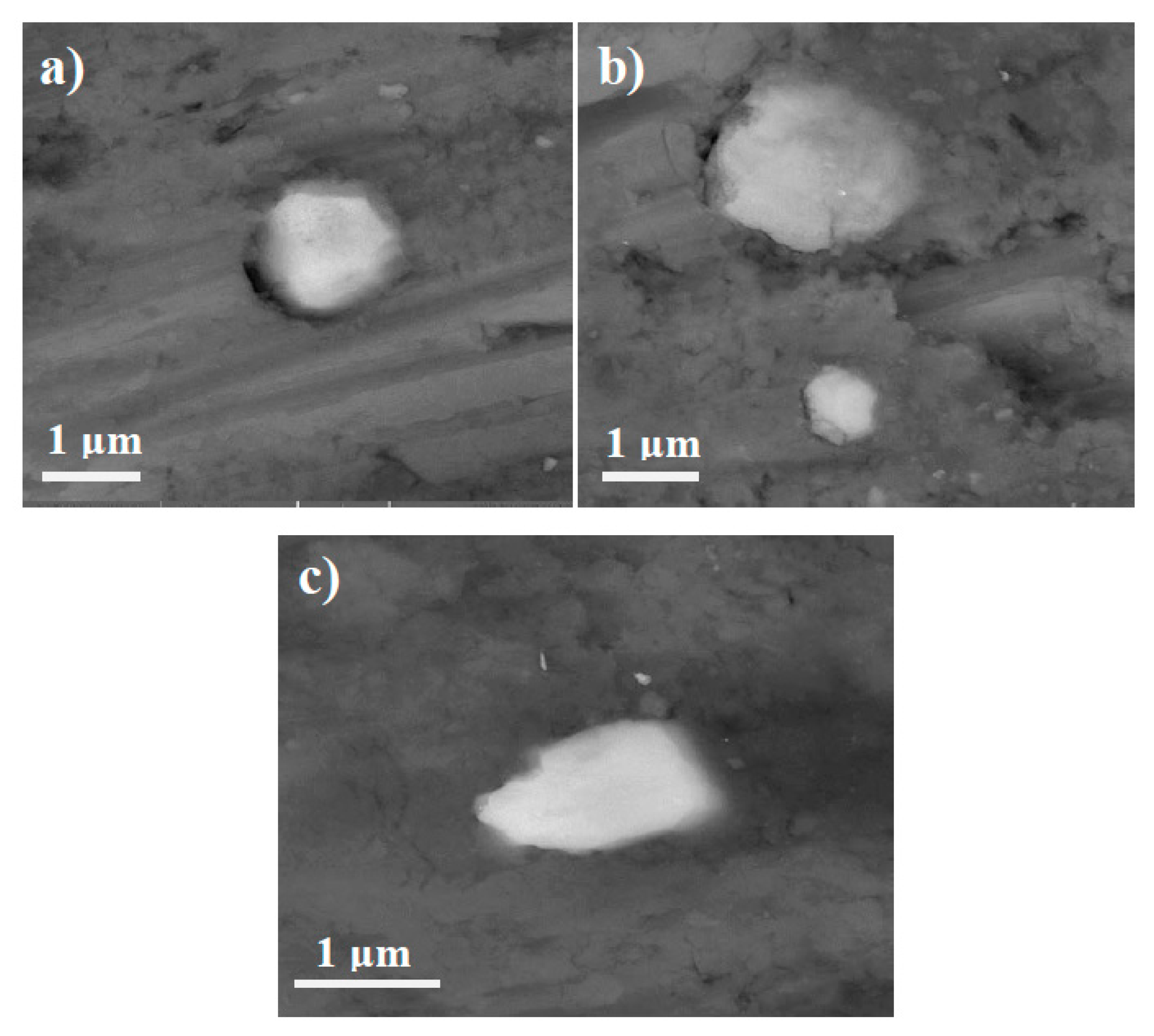
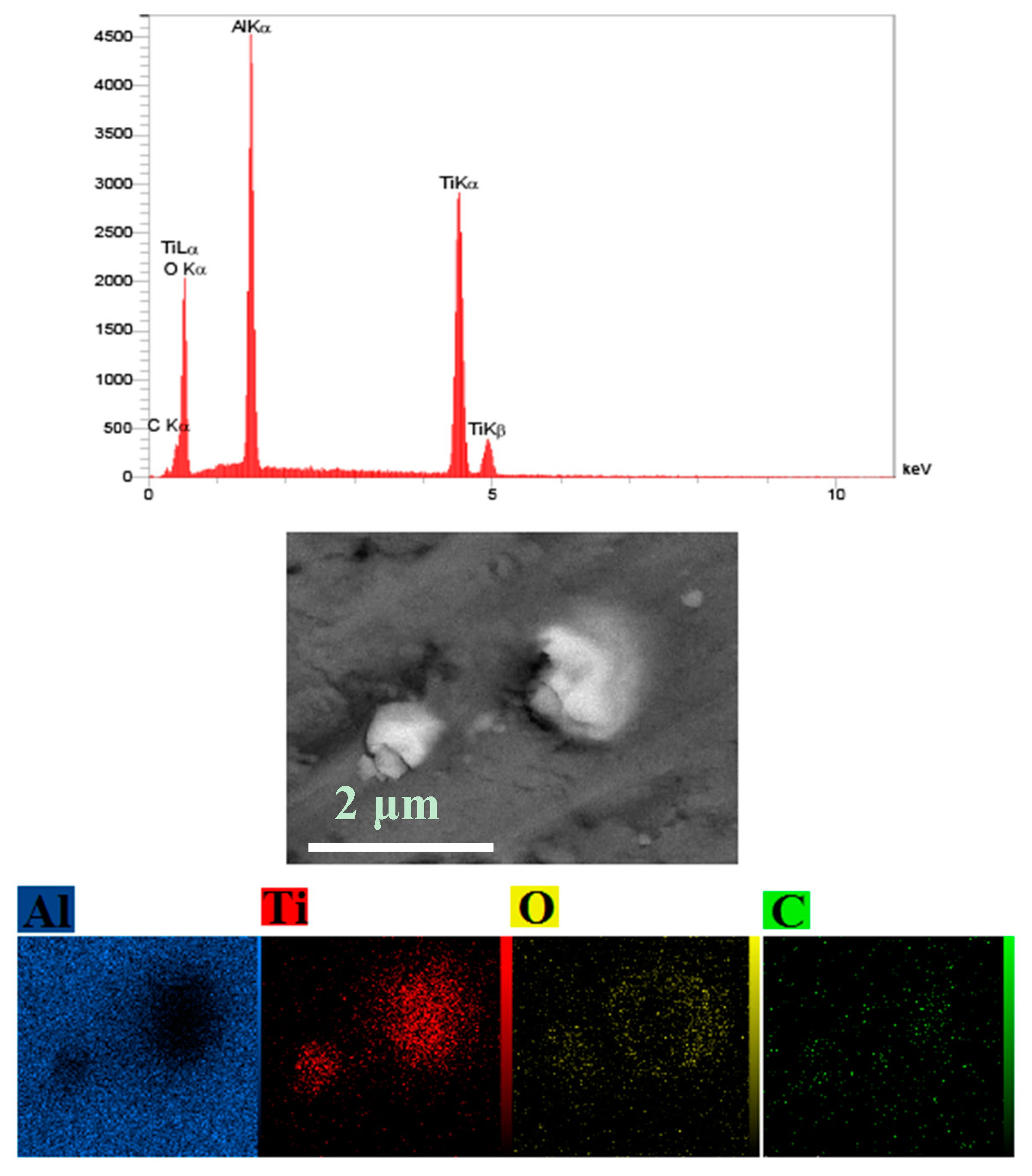
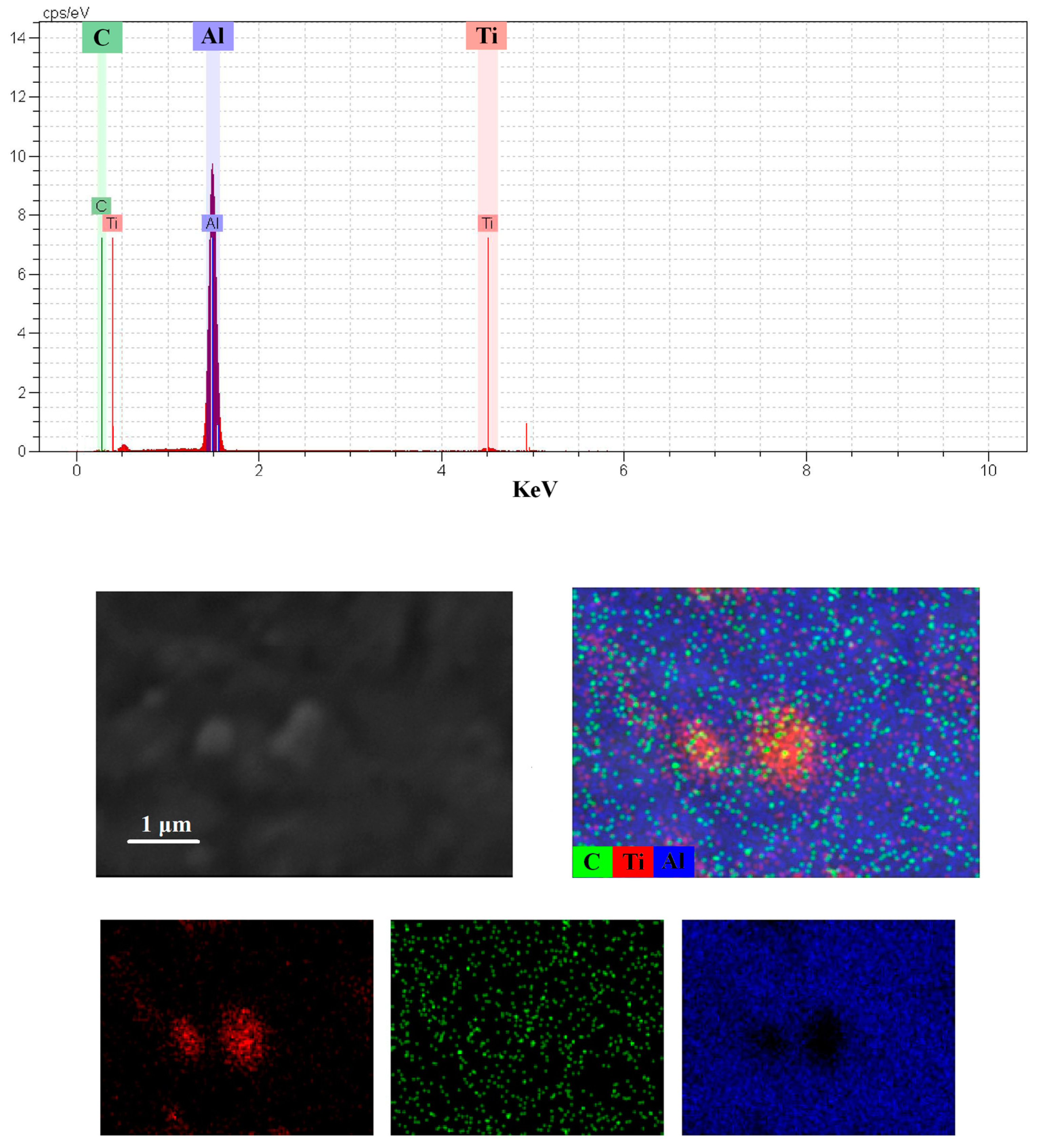
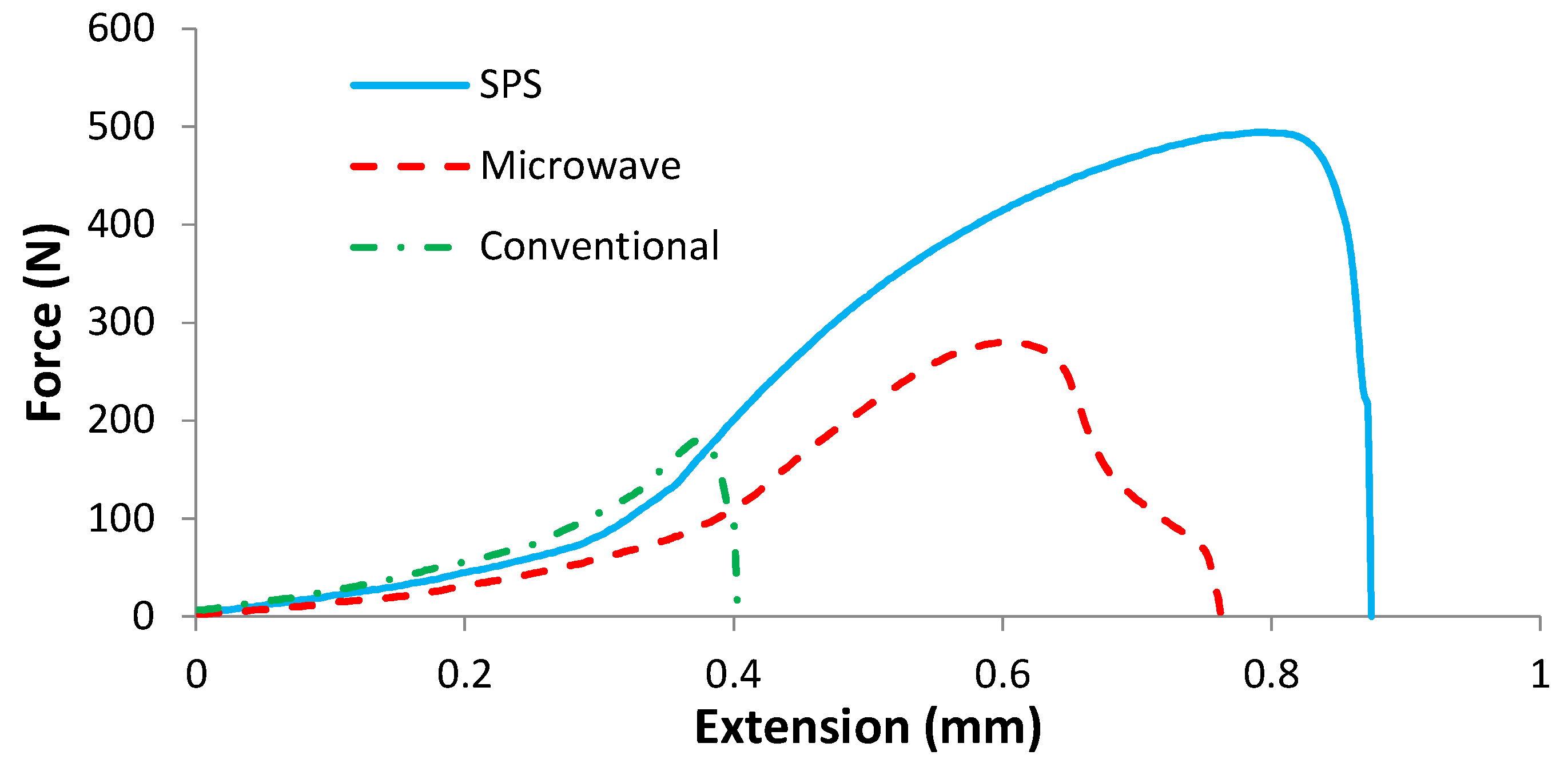
| Sample | Density (gr/cm3) | Bending Strength (MPa) | Microhardness (Vickers) |
|---|---|---|---|
| SPS | 2.88 ± 0.01 | 291 ± 12 | 253 ± 23 |
| Microwave | 2.76 ± 0.03 | 134 ± 21 | 110 ± 15 |
| Conventional | 2.60 ± 0.02 | 95 ± 9 | 80 ± 13 |
© 2017 by the authors. Licensee MDPI, Basel, Switzerland. This article is an open access article distributed under the terms and conditions of the Creative Commons Attribution (CC BY) license (http://creativecommons.org/licenses/by/4.0/).
Share and Cite
Ghasali, E.; Fazili, A.; Alizadeh, M.; Shirvanimoghaddam, K.; Ebadzadeh, T. Evaluation of Microstructure and Mechanical Properties of Al-TiC Metal Matrix Composite Prepared by Conventional, Microwave and Spark Plasma Sintering Methods. Materials 2017, 10, 1255. https://doi.org/10.3390/ma10111255
Ghasali E, Fazili A, Alizadeh M, Shirvanimoghaddam K, Ebadzadeh T. Evaluation of Microstructure and Mechanical Properties of Al-TiC Metal Matrix Composite Prepared by Conventional, Microwave and Spark Plasma Sintering Methods. Materials. 2017; 10(11):1255. https://doi.org/10.3390/ma10111255
Chicago/Turabian StyleGhasali, Ehsan, Ali Fazili, Masoud Alizadeh, Kamyar Shirvanimoghaddam, and Touradj Ebadzadeh. 2017. "Evaluation of Microstructure and Mechanical Properties of Al-TiC Metal Matrix Composite Prepared by Conventional, Microwave and Spark Plasma Sintering Methods" Materials 10, no. 11: 1255. https://doi.org/10.3390/ma10111255




